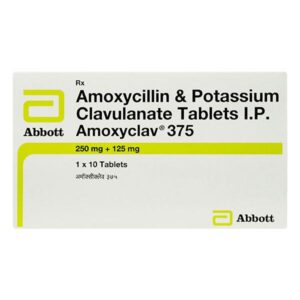AMOXYCILLIN + CLAVULANATE
Amoxycillin: Amoxicillin is a widely used antibiotic that belongs to the penicillin class. It is commonly prescribed to treat various bacterial infections, including respiratory tract infections, urinary tract infections, skin infections, and ear infections.
The mechanism of action of amoxicillin involves interfering with the synthesis of the bacterial cell wall. It does this by inhibiting the transpeptidation step of peptidoglycan synthesis, which is a vital component of the bacterial cell wall. Without a functional cell wall, bacteria are unable to survive and replicate.
Amoxicillin is available in different formulations, including tablets, capsules, and oral suspension. The dosage can vary depending on the severity of the infection, weight, and age of the patient. It is important to strictly follow the prescribed dose and duration of treatment as advised by the healthcare professional.
Common side effects of amoxicillin may include diarrhea, nausea, vomiting, abdominal pain, and skin rashes. These side effects are usually mild and transient. However, in rare cases, amoxicillin may cause more severe adverse reactions like allergic reactions, including anaphylaxis, which can be life-threatening. It is crucial to inform your doctor if you experience any unusual or severe side effects while taking amoxicillin.
It is important to note that amoxicillin is only effective against bacterial infections and will not treat viral infections, such as the common cold or flu. It is always necessary to consult a healthcare professional before taking any medication to ensure appropriate diagnosis and treatment.
Clavulanate: Clavulanate is not a drug on its own, but it is often combined with amoxicillin to create a combination antibiotic called amoxicillin-clavulanate or co-amoxiclav.
Use: Co-amoxiclav is primarily used to treat various bacterial infections, including respiratory tract infections, urinary tract infections, skin and soft tissue infections, and dental infections. It is also effective in treating certain types of pneumonia, sinusitis, and otitis media.
Mechanism of Action: Clavulanate, a beta-lactamase inhibitor, is added to amoxicillin to increase its effectiveness against bacteria that produce beta-lactamase enzymes. Beta-lactamase enzymes are responsible for breaking down the beta-lactam ring in antibiotics, rendering them ineffective. By inhibiting the beta-lactamase enzymes, clavulanate allows amoxicillin to exert its bactericidal activity against a broader spectrum of bacteria.
Dose: The dose of co-amoxiclav depends on the severity of the infection and may differ based on the patient’s age, weight, and renal function. It is available in various strengths, such as 250mg/125mg, 500mg/125mg, and 875mg/125mg. The recommended dosing can vary but typical adult doses range from 250mg/125mg to 875mg/125mg taken every 8 or 12 hours, depending on the infection being treated.
Side Effects: Common side effects of co-amoxiclav include diarrhea, nausea, vomiting, abdominal discomfort, skin rash, and headache. These side effects are usually mild and temporary. However, some individuals may experience more severe side effects such as severe allergic reactions, liver problems, or blood disorders. It is important to seek medical attention if any serious side effects occur.




